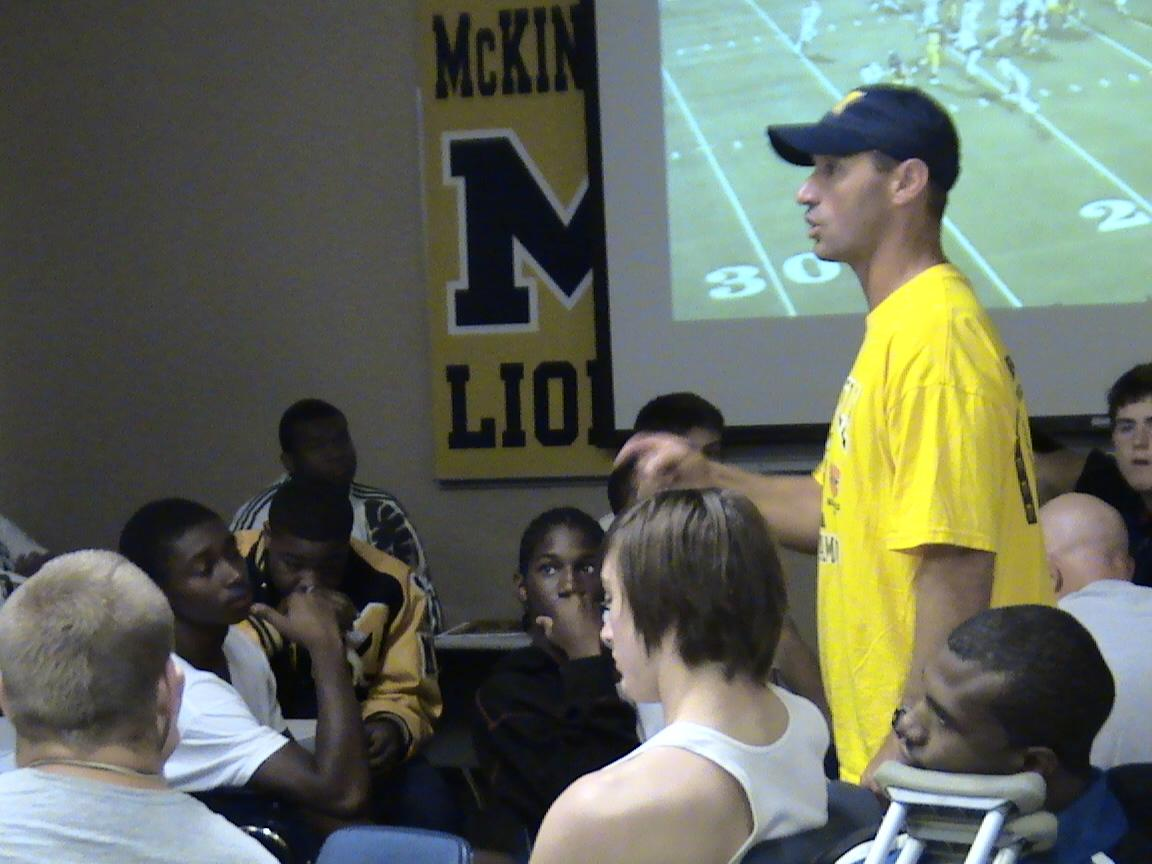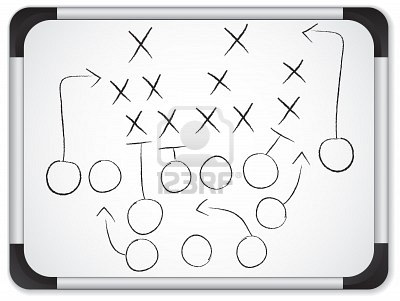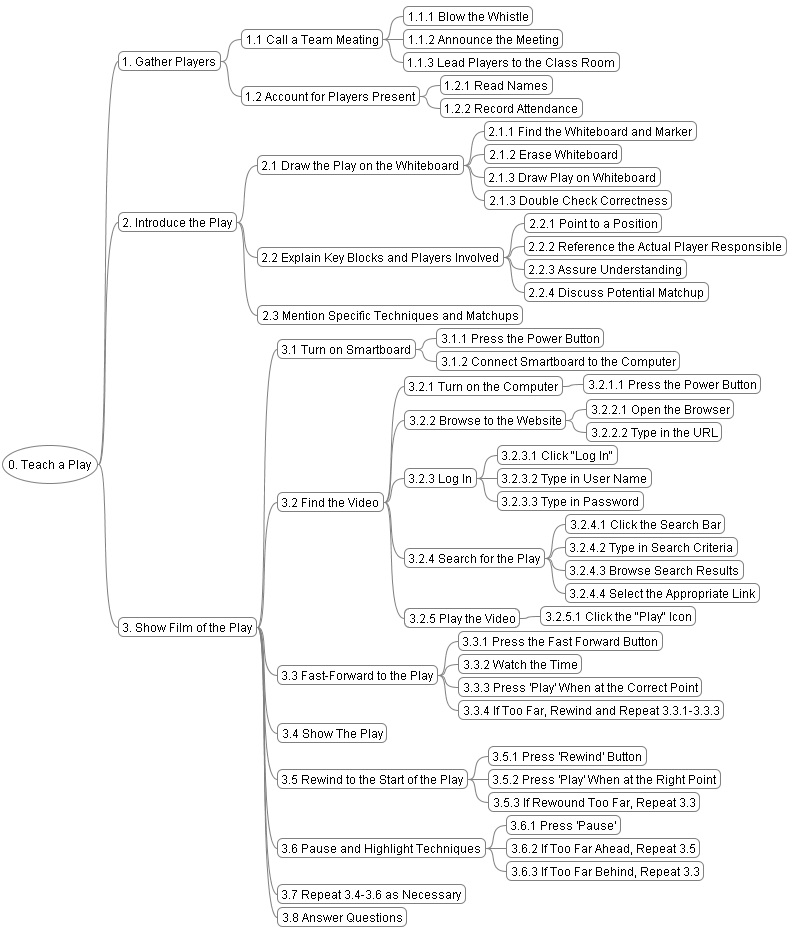Phase 1 · Summaries
Artifact Analysis
FILM

A football coach reviews film with his players.
This is perhaps the most ubiquitous and necessary of artifacts related to coaching. From highschool to the NFL, players and coaches rely on film for a variety of advantages. In highschool, film was used to teach new plays to the team. They would watch proper execution as performed at the professional or college level on film. Additionally, all levels use film to analyze upcoming opponents. Film allows the team to observe specific players, specific plays, and how the opposition reacts under certain conditions. Additionally, it allows a team to reflect on their own execution. A poor performance can be studied on film to correct such mistakes moving forward. Furthermore, film can exist on a variety of mediums. Eastern Montgomery, for example, utilized a Smartboard to analyze film. This amplifies the value of the artifact further by increasing its functionality. The coach can use the Smartboard's touch interface, for example, to zoom in on an area of interest or highlight routes.
PLAYBOOK

This artifact is the tome of knowledge in the football world. It contains every play a coach might execute in a given game. The playbook is usually a binder. It is accessed like an encyclopedia or a textbook. Given a certain situation or matchup, the coach might reference this artifact for specific plays to make an opponent's weakness even weaker or to counterbalance their strength. The quarterback's armband is an abridged reference to this.
QB WRISTBAND

This is essentially the quarterback's map of the playbook. It secures around the forearm and contains a legend of the plays planned for that game. A number corresponds to each play allowing the coach to communicate without revealing his intention to the opponent. The quarterback will reference this artifact, much like a watch, and relay the translated information to his fellow players. For example, "thirty two" might refer to a quarterback sneak. When the coach yells "Thirty two!" the quarterback will reference his wristband and reveal the play as a quarterback sneak in the huddle.
WHITEBOARD

The whiteboard is an indispensible artifact. At the highschool level it's used in the locker room. It allows plays to be visualized and reviewed on the fly. This type of coaching usually occurs in a classroom atmosphere with players gathered around. It is analogous to a chalkboard used educationally to relay a variety of information in a relatively short period of time. The advantage over film is that the coach can more quickly replicate different approaches the opponent might take to handle a certain play. Information can be partially or completely erased to make way for whatever the coach deems valuable.
Stakeholder Profiles
Players -
Goals: To achieve a higher level of greatness. This can be reaching the "next level" for a highschool player seeking a college career or a college player seeking a position in the NFL. Even at that level, players seek to become world champions in the Super Bowl.
Concerns: Avoiding injury, remaining competitive, getting reps (playing regularly as a starter).
Expectations: Players are expected to be in peak physical condition. Mentally they are required to memorize a complex system of plays and remain focused enough to avoid penalties or costly mistakes.
Coaches -
Goals: To garner long term success by developing a consistent core of competitive athletes. To guide the team to championships.
Concerns: The opposing team. Their own competence.
Expectations: Coaches are expected to select the best player for the job. They are expected to carry the burden if the team doesn't perform well. They are expected to select the right plays for a given situation.
Community -
Goals: The goal of the community in football is to experience a sense of togetherness behind the banner of their team.
Concerns: Safety of the players.
Expectations: They are expected to remain courteous and respectful. They are expected to cheer and increase morale.
Franchise -
Goals: No matter the level, a franchise seeks to win a championship.
Concerns: Fan loyalty.
Expectations: Any franchise is expected to adequately represent itself.
Sponsors -
Goals: Ensuring that investments return a profit. Selecting the right "face" for their product
Concerns: Protecting their brand image.
Expectations: To produce quality products. To reward exceptional performance.
Task Analysis
Observed and Discussed Tasks
Player - Showing up to practice; staying in top physical condition; contributing to victories; maintaining a level of decency that reflects well on the franchise; learn the plays
Coach - Studying opposing teams; selecting the best players for the job; selecting the right plays; training and teaching the players;
Community - Showing up to games; cheering for the team; boosting morale
Franchise - Organizing public relations; ensuring the right coach is in place; disciplining players and coaches;
Sponsors - Making sure their brand is on the most popular/visible candidates; ensuring that their investments return a profit; maintaining the image of their brand
Task Analysis - Teaching a Play

Examination
More than Numbers
Through our interviews we learned that football is more than just a game of numbers, we learned that play calling takes into account many factors in addition to statistics. Coaches use a variety of methods to choose their plays and each coach has a unique methodology to his or her decisions.
The Importance of Film
Through our examination of the artifacts of football, our interviews with players and staff, and observations drawn from watching football we noticed several common threads. One major theme we noticed was the importance of film to teams. Whether in highschool or college, the interviewees made it clear that film was the most viable weapon in defending against opponents, correcting one's own weaknesses, and at the highschool level even learning new plays. Ultimately the problem definition revolves around one primary relationship. That relationship is between the coach and the players. The consequence of properly utilizing film to prepare players for opponents is that they win. Winning is the single most important factor woven between all stakeholders. A winning franchise is a more successful franchise. A winning community is a happier community. A winning sponsor is a profitable sponsor. When coaches and players win, they are simply doing their job and fulfilling their expectations. Other themes we noticed were the use of pre-set plays, diagraming plays out for players, and emphasizing certain types of plays based on opponent.
As a result of these observations we decided that a good football diagraming tool should include not just a simple digital adaptation of the traditional white board, but should have enhanced functionality that allows coaches to share plays with players, show players video clips from opposing teams, show players videos of the plays they have run in the past, and how those could be improved, and also all allow players to see how they mach up against opponents.